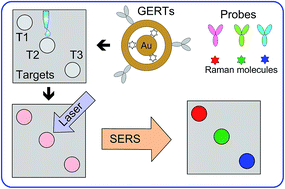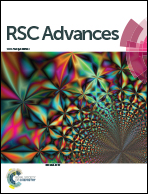Quantitative and multiplex dot-immunoassay using gap-enhanced Raman tags†
Abstract
Dot immunoassay has been proposed as a simple and fast method for detection of various analytes. However, this qualitative method has a narrow working range and is limited to multiplex detection. To overcome these drawbacks, we suggest a highly specific, quantitative, and multiplex dot immunoassay using plasmonic gap-enhanced Raman tags (GERTs) and a nitrocellulose membrane as a substrate. The assay principle is based on reading surface-enhanced Raman scattering (SERS) spectra from analyte drops on the membrane strip after incubation with GERTs conjugated to biospecific probes. Three types of GERTs were synthesised by embedding nitrobenzenethiol (NBT), naphthalenethiol (NT), and acetamidothiophenol (AcTP) Raman molecules inside Au core/shell nanoparticles. For proof-of-concept experiments, the NBT, NT, and AcTP GERTS were further functionalized with rabbit anti-rat, anti-human, and anti-chicken antibodies, respectively. For all three corresponding antigens, the detected Raman signals linearly depended on the analyte amount within the range from 10 to 300 ng. The multiplex capability of the assay is illustrated by simultaneous one-step determination of rat, human, and chicken IgGs with a mixture of functionalized GERTs by recording Raman maps for whole membrane to avoid the point-to-point repeatability problem. Thus, GERTs are promising SERS nanotags for advanced versions of immunoassays instead of common plasmonic SERS labels with Raman reporters excited by the external near field.



 Please wait while we load your content...
Please wait while we load your content...